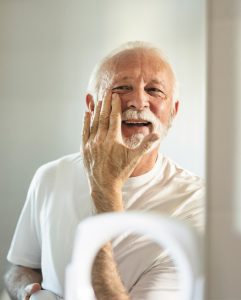By Katie Keel, APRN-C
 When it comes to skin care, men have traditionally kept it simple. However, more men are now pursuing healthier, younger-looking skin, making it a great time for men to evaluate their skin care routine and learn more about how to take care of their body’s largest organ. Although there are key differences between men and women’s skin — for example, men’s skin is thicker than women’s — the basic elements of an effective skin care plan remain the same.
When it comes to skin care, men have traditionally kept it simple. However, more men are now pursuing healthier, younger-looking skin, making it a great time for men to evaluate their skin care routine and learn more about how to take care of their body’s largest organ. Although there are key differences between men and women’s skin — for example, men’s skin is thicker than women’s — the basic elements of an effective skin care plan remain the same.
To help men develop healthy skin care routines, dermatologists recommend the following tips:
Consider product labels and ingredients. The skin care products you choose will depend on your skin type. If you have acne-prone skin, look for cleansers and moisturizers that say “oil free” or “non-comedogenic,” as these won’t clog your pores. If you have sensitive skin, use mild,
“fragrance free” products, as products containing fragrances can leave skin feeling irritated and dry. However, beware of products labeled “unscented,” as many of these contain masking fragrances that can still irritate your skin.
Wash your face daily and after exercise. Because regular bar soap often contains harsh ingredients that can be drying to the skin, wash your face with a mild facial cleanser and lukewarm — not hot — water.
Watch your shaving technique. For some men, multi-blade razors can work too well or shave too closely to your skin. If you often experience razor bumps, razor burns, or ingrown hairs, use a single- or double-blade razor instead and do not stretch your skin taut while shaving. Before you shave, wet your skin and hair to soften it. Use a moisturizing shaving cream and shave in the direction of hair growth. Rinse after each swipe of the razor, and change your blade after five to seven shaves to minimize irritation.
Moisturize daily. Moisturizer works by trapping water in your skin, which can help reduce the appearance of fine lines and make your skin look brighter and younger. For the best results, apply moisturizer to your face and body immediately after bathing, showering or shaving while the skin is still damp.
Check your skin regularly. New spots or moles that itch, bleed, or change color are often early warning signs of skin cancer. If you notice any suspicious spots, make an appointment to see a dermatologist. Men over age 50 have a higher risk of developing melanoma, the deadliest form of skin cancer, than the general population. However, when caught early, skin cancer is highly treatable.
Wear sunscreen whenever outdoors. To help prevent sun damage that can lead to wrinkles, age spots and even skin cancer, before going outdoors, apply sunscreen to all exposed areas of skin, including your scalp, ears, neck and lips. For best protection, use a broad-spectrum, water-resistant sunscreen with an SPF of 30 or higher and reapply every two hours or immediately after swimming or sweating. You can also protect your skin by seeking shade and wearing sun-protective clothing, such as a lightweight and long-sleeved shirt, pants, a wide-brimmed hat and sunglasses with UV protection, when possible. For more effective sun protection, select clothing with an ultraviolet protection factor (UPF) label.
Every man’s skin is different, and there is no “one size fits all” approach to skin care. If you aren’t sure what skin type you have, or if have questions about how to take care of your skin, see one of our dermatologists!
Melanoma Strikes Men Harder
Researchers have found yet another way that men and women differ. Melanoma, the most-serious skin cancer, affects the sexes differently. Men are more likely to die of melanoma than women. This is true at any age. White adolescent males and young adult men are about twice as likely to die of melanoma as are white females of the same age.
By age 50, men are also more likely than women to develop melanoma. This number jumps by age 65, making men 2 times as likely as women of the same age to get melanoma. By age 80, men are 3 times more likely than women in that age group to develop melanoma.
One reason Melanoma strikes men harder may be that men know less about skin cancer. A survey conducted by the American Academy of Dermatology in 2016 found that less than 50% of men knew there was no such thing as a “healthy tan”, or that skin cancer can develop on skin that gets even minimal sun exposure. With less knowledge, it’s natural that men are less likely to protect their skin from the sun.
Sun protection can lower men’s risk of getting melanoma. While sun protection alone cannot explain why men are hit harder, we know that it can reduce the risk of getting melanoma. Men who dislike applying lotions and creams can still protect their skin from the sun. When outdoors, even on cloudy days, men can:
• Put on a wide-brimmed hat and sunglasses
• Seek shade whenever possible
• Wear long sleeves and pants when possible
• Stay out of the sun when the sun’s rays are strongest (from 10 a.m. to 2 p.m.)
It’s a proven fact that sunscreen also helps. Sunscreen can protect skin not covered by clothing. To encourage men to wear sunscreen, there are sunscreens formulated just for men. To get the needed sun protection, the AAD recommends wearing sunscreen that offers SPF 30, broad-spectrum protection, and water resistance.
 Central Florida Health and Wellness Magazine Health and Wellness Articles of the Villages
Central Florida Health and Wellness Magazine Health and Wellness Articles of the Villages



